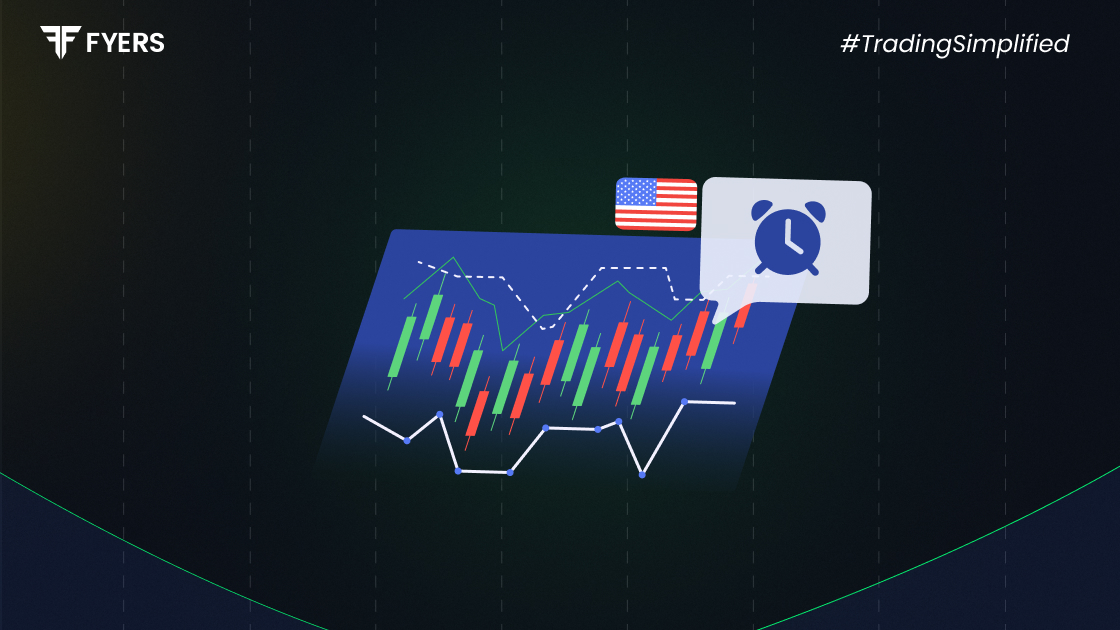

 29 Jun, 2025
29 Jun, 2025
 4 mins read
4 mins read

For Indian investors and traders keeping an eye on global markets, the US stock market timings play a crucial role. Being home to some of the world's biggest companies, the US stock exchanges often influence global and domestic market sentiment. Whether you're looking at the S&P 500, NASDAQ, or Dow Jones, understanding the trading hours - including pre-market and after-hours sessions - is essential.
In this blog, we’ll walk you through the opening and closing times of the US stock markets, their impact in India, and how Indians can participate in them.
The regular trading session of the US stock market runs from 9:30 AM to 4:00 PM Eastern Time (ET), Monday to Friday, excluding public holidays.
This window is when most trading activity occurs, and it's when the majority of market-moving news is released or reacted to.
|
Summary:
|
This is the most active period for institutional traders, investors, and brokers, with high liquidity and tight spreads.
Before the regular session starts, the pre-market trading hours allow early trades based on news or earnings released outside normal hours.
Timing: 4:00 AM to 9:30 AM ET
Purpose: Allows investors to react to overnight developments, economic data, or company announcements.
However, trading volume during pre-market hours is relatively low, and prices may be more volatile due to fewer participants.
Similarly, after-hours trading begins after the regular session closes:
Timing: 4:00 PM to 8:00 PM ET
Use Case: Useful for reacting to late-breaking news, earnings reports, or global events.
Like pre-market, after-hours trading has lower liquidity and wider bid-ask spreads, which increases risk.
Here’s a quick overview of the major US stock exchanges and their standard trading hours (in ET):
|
Exchange |
Trading Hours (ET) |
|---|---|
|
New York Stock Exchange (NYSE) |
9:30 AM – 4:00 PM |
|
NASDAQ |
9:30 AM – 4:00 PM |
|
Chicago Board Options Exchange (CBOE) |
9:30 AM – 4:00 PM |
|
NYSE American |
9:30 AM – 4:00 PM |
All these exchanges also support pre-market and after-hours trading sessions through electronic communication networks (ECNs).
The US observes Daylight Saving Time (DST), which usually begins in March and ends in November. During DST, clocks are set one hour ahead, and this affects the US stock market opening time for international traders.
Standard Time (November to March): India is 10.5 hours ahead of ET.
DST (March to November): India is 9.5 hours ahead of ET.
So, Indian investors need to adjust their tracking or trading accordingly.
Given the time difference, here's when US markets operate in Indian Standard Time (IST):
Regular Session (Standard Time): 8:00 PM to 2:30 AM IST
Regular Session (DST): 7:00 PM to 1:30 AM IST
So if you're checking the US stock market time today in India, be sure to consider whether DST is in effect.
Many Indian investors and traders follow the US stock market timings because:
Global Sentiment: Movements in the US market often influence Indian markets.
Big Tech Exposure: Companies like Apple, Amazon, and Tesla are listed in the US but have global operations that affect worldwide trends.
Earnings Announcements: US earnings season can affect global investor mood and sector-specific trends.
Economic Indicators: US economic data such as GDP, unemployment, and inflation have global impact.
Monitoring the US market helps Indian traders anticipate possible trends in domestic trading sessions.
With technological and regulatory advancements, Indians can now trade in the US stock market from India through a few routes:
Under RBI's LRS, Indian residents can remit up to USD 250,000 per financial year for overseas investments, including stocks.
Many Indian brokers now partner with US brokerage firms or fintech platforms that enable retail investors to buy shares of US-listed companies.
Another option is to invest in mutual funds or ETFs with global exposure, particularly US equities.
Factor in currency conversion rates and foreign transaction fees.
Understand the tax implications under Indian law.
Know that not all US-listed securities may be available through Indian platforms.
Understanding the US stock market opening and closing time, especially in Indian time, is essential for those who actively trade or invest in global equities. Whether you're tracking market sentiment or planning direct investments, knowing about pre-market trading hours US, after hours trading US, and time zone changes can help you make informed decisions.
While the US markets aren’t open 24 hours, extended trading hours provide additional opportunities to respond to news and events outside regular sessions. And thanks to liberalised rules and digital platforms, how to trade in US stock market from India is now simpler than ever - opening doors to the world’s largest capital market.
During Standard Time (Nov–Mar), it opens at 8:00 PM IST. During Daylight Saving Time (Mar–Nov), it opens at 7:00 PM IST.
During DST, the regular trading hours shift to 7:00 PM to 1:30 AM IST for Indian traders.
Yes, Indian residents can trade in US stocks under the RBI’s Liberalised Remittance Scheme (LRS) via international investment platforms or mutual funds.
No, but electronic trading is available during pre-market (4:00 AM to 9:30 AM ET) and after-hours (4:00 PM to 8:00 PM ET) sessions. Regular hours are from 9:30 AM to 4:00 PM ET.
Calculate your Net P&L after deducting all the charges like Tax, Brokerage, etc.
Find your required margin.
Calculate the average price you paid for a stock and determine your total cost.
Estimate your investment growth. Calculate potential returns on one-time investments.
Forecast your investment returns. Understand potential growth with regular contributions.